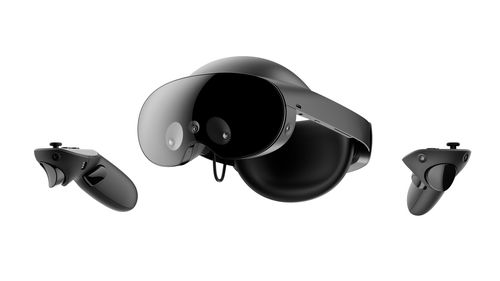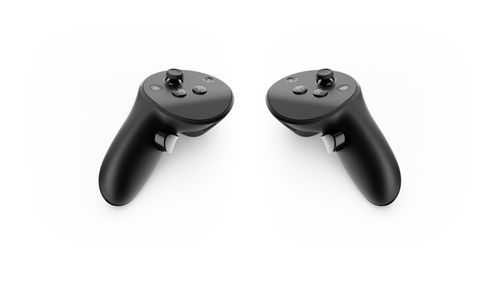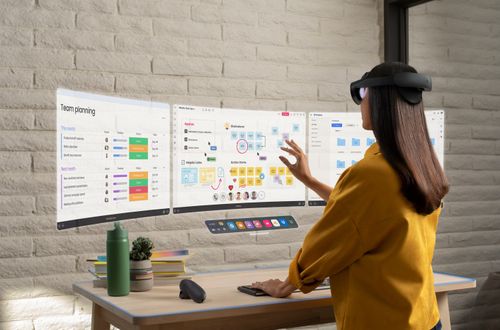And finally, we have a look at Mark Zuckerberg’s dream of a high-end headset.
It’s called the Meta Quest Pro, and it isn’t cheap.
What’s included in the bundle?
For $2449.99, you get the headset itself and the Meta Quest Touch Pro controllers.
Accessories like stylus tips, partial light blockers and a charging dock are also included.

The Meta Quest Pro is a standalone headset.
Powered by a new Qualcomm chip, it doesn’t need to be connected to an external PC, console or mobile device to work.
Its major selling point is mixed reality: combining the world around you with virtual elements.
Cameras pick up your surroundings which are then displayed in full colour through “pancake optics” (I didn’t make that up), a “stack” of circular lenses that boost clarity and contrast while minimising the size of the headset.

Unlike other headsets, the Meta Quest Pro keeps its sides for peripheral vision.
Magnetic “light blockers” are included in the box so you can block out the world if you wish but, with a focus on mixed reality, they’re optional for a reason.
Sensors on the inside of the Meta Quest Pro track your eyes and facial movements, which can then be mimicked by a virtual avatar in online spaces.
The cameras can also track your hands if you’re not using the new controllers.
The controllers now track themselves (they used to be tracked by cameras on the headset), have ditched the older “halo” design being adopted by the PlayStation VR2 and have been loaded with more precise rumble for improved touch sensations.
Meta has added a flat panel that pushes into the controllers too, which combines with a trigger for a more realistic “pinching” input for picking up and dropping objects.

Who is Meta Quest Pro for?
Anyone could buy one, but big business is expected to be an early adopter.
Its website specifically calls out “architects, engineers, builders, creators, and designers who want to augment their workflow and supercharge their creativity with the power of VR”.
Meta and Microsoft have partnered to bring Microsoft Teams, Windows 365 and more to the platform and integrate features like Meta Avatars into virtual meeting rooms.

Quest for Business – a subscription bundle for Meta Quest 2 and Meta Quest Pro – will bring a suite of admin features like device and app management to the platform next year.
Zuckerberg also debuted an overhauled Horizon Workroom.
These virtual rooms are designed for teams to connect and collaborate in a shared space.
The addition of spatial audio will add a sense of much-needed realism (voices will sound like they’re coming from the correct direction), however the persistence with cartoon-like avatars – reminiscent of the Xbox 360 days – is a limitation that will need to improve with time.
Meta showed off more detailed models to tech reporters in the US who were impressed by the facial details mirrored by the Quest Pro, which is where the technology needs to get to.
Like real breakout rooms, there are sticky notes for whiteboard brainstorming sessions and a new stylus tip that can be added to the controller for better penmanship that (should) translate to more legible handwriting.
Meta says – long-term – it hopes to launch Magic Room, a Zoom integration and 3D model review programs on the Quest Pro.

Meta says its Quest Pro “only collects the data needed for your device, and any features you turn on, to function optimally”.
Some of its most impressive features, eye tracking and natural facial expressions, are off by default.
When you opt in, Meta says “images of your eyes and face stay on the headset, are deleted after processing, and are never shared with Meta or third-party apps”.

Meta Quest Pro can certainly be used to play games and experience the broad range of VR entertainment – it’s just not a cheap entry point.
Some of the amazing tech developed by Melbourne’s PHORIA was shown off as part of the Quest Pro’s launch.
As was a trailer for an Iron Man game – which came out on PS4 in 2020 – but, sensationally, not a single frame of gameplay was shown.
The technology is there but the biggest problem with gaming in VR continues to be the breadth and quality of the titles on offer.
The arrival of older classics like Resident Evil 4 in VR is going some way to rectify this and – if you’ve never played VR games before – the library is growing, just don’t expect a flood of new amazing games to arrive with the Meta Quest Pro.

VR isn’t new but it’s still very much an emerging technology.
Meta’s standalone headsets are among the most user friendly, without having to worry about owning an external device or a mess of cables that you can get tangled in.
On the surface, Meta Quest Pro appears to be another step in the right direction.
But boy, is it an expensive step.
When the Meta Quest 2 retails for $699, most wanting to dabble in VR would scoff at its $2449 asking price.
However it’s important to remember that the Meta Quest Pro is made with work in mind.
We’ll have to go hands-on ourselves before commenting on its comfort and quality.
I’m not sure people will want to collaborate with others as avatars – something I mentioned in my hands-on with Cisco’s “hologram” technology – or wear a device on their heads for large chunks of a working day for that matter, but Zuckerberg is committed to making the Metaverse a thing.
Time will tell if the creator of Facebook has another hit up his sleeve.


Be the first to comment